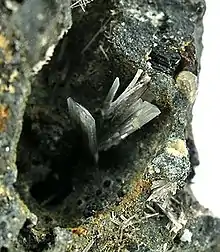| Laurionite | |
|---|---|
 Laurionite crystals in a vug from the Laurium district of Greece | |
| General | |
| Category | Halide minerals |
| Formula (repeating unit) | PbCl(OH) |
| IMA symbol | Lri[1] |
| Strunz classification | 3.DC.05 |
| Crystal system | Orthorhombic |
| Crystal class | Dipyramidal (mmm) H-M symbol: (2/m 2/m 2/m) |
| Space group | Pnma |
| Unit cell | a = 7.111, b = 9.6987 c = 4.0203 [Å]; Z = 4 |
| Identification | |
| Color | Colorless, white |
| Crystal habit | Elongated tabular prismatic crystals |
| Cleavage | Distinct on {101} |
| Tenacity | Flexible |
| Mohs scale hardness | 3 - 3.5 |
| Luster | Adamantine, pearly |
| Streak | White |
| Diaphaneity | Transparent |
| Specific gravity | 6.241 |
| Optical properties | Biaxial (-) |
| Refractive index | nα = 2.077 nβ = 2.116 nγ = 2.158 |
| Birefringence | δ = 0.081 |
| 2V angle | Measured: 70° |
| Solubility | Sleight in cold water |
| References | [2][3][4][5] |
Laurionite (PbCl(OH)) is a lead halide mineral. It forms colorless to white crystals in the orthorhombic crystal system and is dimorphous with paralaurionite, both members of the matlockite group.[2]
It was first described in 1887 for an occurrence in the Laurium District, Attica, Greece, and named after the town Laurium.[2] It occurs as an oxidation product in lead ore deposits, and is also produced on lead-bearing slag by reaction with saline solutions. It occurs associated with paralaurionite, penfieldite, fiedlerite, phosgenite, cerussite and anglesite.[3]
References
- ↑ Warr, L.N. (2021). "IMA–CNMNC approved mineral symbols". Mineralogical Magazine. 85 (3): 291–320. Bibcode:2021MinM...85..291W. doi:10.1180/mgm.2021.43. S2CID 235729616.
- 1 2 3 Mindat.org
- 1 2 Handbook of Mineralogy
- ↑ Webmineral data for laurionite
- ↑ Mineralienatlas
This article is issued from Wikipedia. The text is licensed under Creative Commons - Attribution - Sharealike. Additional terms may apply for the media files.